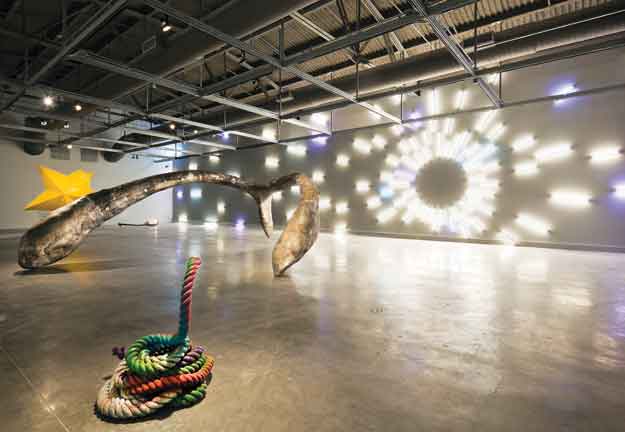« Reviews
Mark Handforth: Rolling Stop

“Mark Handforth: Rolling Stop” exhibit at Museum of Contemporary Art | North Miami. Photo: Steven Brooke.
Museum of Contemporary Art - North Miami
Curated by Bonnie Clearwater
By Heike Wollenweber
We often look past what we see daily on the streets of our cities and in the night skies above while getting caught up in the hustle and fast pace of urban life. With “Rolling Stop,” Mark Handforth reinterprets the city and stretches the boundaries of art by exploring space and challenging its limitations.
With gigantic sculptures and light fixtures, Handforth creates his own urban myth, uniting his interpretations of the European and American metropolises. Having lived primarily in the U.K., Germany and Florida, Handforth has an intimate understanding of the urban setting, how it is shaped and how in return it shapes its inhabitants. European cities are often built on a strong sense of history, while cities in the USA are focused on the future, the new, and all energy circulates around what is next. The combination of those definitions elevates the art beyond geographical or cultural boundaries and constraints.
The grandeur of the metropolis manifests itself in his art particularly in the enormity of his sculptures, but Handforth then goes beyond the physical attributes and engages viewers in a continuous urban discourse. He alters everyday objects of city life, such as street signs, trash cans and lampposts, and creates something that is entirely new without losing the inherent essence.
“Rolling Stop” is not about realistic representation. Handforth, rather, adds a comical touch when moving the ordinary into the realm of art. Street signs are bent and distorted, a wire hanger is 27 feet tall, a wishbone sits next to a golden telephone, and brightly colored ropes have twisted a garbage can. Handforth likes to play with movement and change. His art often retains a certain fluidity, and many of his works, primarily his light fixtures, incorporate motion. A moon is weeping as neon tears light up in sequence, and a Vespa is moving, not on wheels, but rather via dripping candle wax representing such continuous flux.
Handforth’s art is more process than finished product, a quality also of the modern city. The city lights symbolize life, change, movement and progress in our daily lives, and neon signs are part of what defines the modern city. Handforth explores the concept of the city further by creating his light fixtures. The lights hit the sculptures to create new shapes and shadows, hereby altering not just the aesthetical appearance of the art but also the emotional impact.
Space and its limitations are dominant themes. Handforth addresses the geographical boundaries of space as well as the socioeconomic boundaries that often limit art by moving his work beyond the museum walls. Handforth’s work typically disregards the expected norms as he endorses public art, accessible to everyone. The public space also lends a certain organic quality to the art, as the ever-changing environment and forces of nature alter the art while the art itself alters the environment in which it is placed.
“Rolling Stop” is Handforth’s interpretation of the city, mixing grittiness with the fantastic while incorporating comical elements. Walking through the exhibit, underneath and in between enormous signs and bones, one felt part of a fairy-tale scenario, dwarfed all of a sudden by what we see every day. Space and size take on new meanings, as do the subjects of Handforth’s sculptures as he stretches the physical limitations of art and invites viewers to engage in a discourse with their surroundings, offering a new understanding of urban existence.
(November 30, 2011 - February 19, 2012)
Heike Wollenweber is an arts writer based in Miami.
Filed Under: Reviews


































